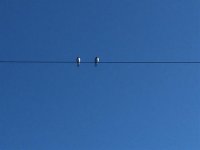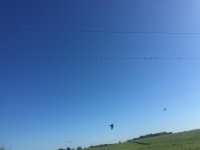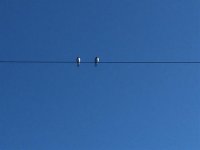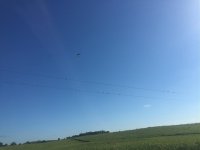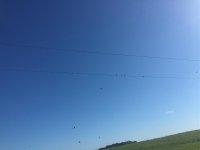My identification app shows this bird as eastern kingbird but they do not have the white tipped tails. Saw them near Albert Lea MN. Size is between sparrow and robin. Color is black on top and white underneath including neck. I have pictures that I will try to attach. any help would be appreciated.
-
Welcome to BirdForum, the internet's largest birding community with thousands of members from all over the world. The forums are dedicated to wild birds, birding, binoculars and equipment and all that goes with it.
Please register for an account to take part in the discussions in the forum, post your pictures in the gallery and more.
You are using an out of date browser. It may not display this or other websites correctly.
You should upgrade or use an alternative browser.
You should upgrade or use an alternative browser.
Not an eastern kingbird ? (1 Viewer)
- Thread starter Kirkhatr
- Start date
More options
Who Replied?
Hi there and a warm welcome to you from those of us on staff here at BirdForum :t:
It's hard to tell with it being so distant but it looks like an Eastern Kingbird to me but perhaps one of our experts will have a definite answer for you
Please join in wherever you like
It's hard to tell with it being so distant but it looks like an Eastern Kingbird to me but perhaps one of our experts will have a definite answer for you
Please join in wherever you like
BirdInTheTardis
Member
I'd still say they were Eastern Kingbirds, even with the absence of the white tipped tail. Several possibilities could lead to the white not being visible (certain lighting, worn plumage, stained feathers) and so if that was the only inconsistency you noticed, I wouldn't rely too heavily on it being something different for this reason.
The only other common bird I can think of in MN that's dark above, white below, and perches on wires would be Tree Swallows, but they look to have a more bluish sheen and perch very differently.
The only other common bird I can think of in MN that's dark above, white below, and perches on wires would be Tree Swallows, but they look to have a more bluish sheen and perch very differently.
BirdInTheTardis
Member
Oh, and also, welcome to Birdforum! Nice to see a fellow Minnesotan on here 
This is really kind of driving me crazy. I have not been identifying birds that long but usually I can figure them out. This one looks like clear eastern kingbird but bird book says “broad white band at tip of black tail is diagnostic”. So I go back where there are a couple hundred of these birds. No white tip on tail. Not on any of them!
I am puzzled too. They look ok for Tree Swallows, except that at least some of them should be showing forked tails. If there are hundreds together I think it is unlikely they are Eastern Kingbirds, unless this is some kind of flocking behavior with which I am not familiar.
nartreb
Speak softly and carry a long lens
These are swallows. Possibly tree swallows but I'm not certain.
1) The sheer number of them - kingbirds don't crowd together, in fact they're fiercely territorial (in the summer). Family groups are possible for some days just before the fledglings scatter, but you've got eight birds in one photo - too many for a single family.
2) The habit of perching on a wire. Kingbirds can do this of course, especially near a body of water, but it's much more common for swallows to do this.
3) The lack of white on the tail. This is harder to see on a kingbird when the tail is folded, and the pictures aren't super-sharp, but you should see something on at least one of these birds.
4) Look at the birds in flight in the photo. They look like they're following a swallow flight pattern. Kingbirds tend to swoop or hover in such a way that you almost always see the tail spread when you photograph them in flight.
1) The sheer number of them - kingbirds don't crowd together, in fact they're fiercely territorial (in the summer). Family groups are possible for some days just before the fledglings scatter, but you've got eight birds in one photo - too many for a single family.
2) The habit of perching on a wire. Kingbirds can do this of course, especially near a body of water, but it's much more common for swallows to do this.
3) The lack of white on the tail. This is harder to see on a kingbird when the tail is folded, and the pictures aren't super-sharp, but you should see something on at least one of these birds.
4) Look at the birds in flight in the photo. They look like they're following a swallow flight pattern. Kingbirds tend to swoop or hover in such a way that you almost always see the tail spread when you photograph them in flight.
BirdInTheTardis
Member
If you say you saw hundreds, then Tree Swallow it is! Eastern Kingbirds definitely are found in groups that large. And, looking closer at the birds in flight in the second photo, they look more like Swallows than Kingbirds anyway.
tom baxter
Well-known member
These are definitely tree swallows with the exception of the right hand bird that is in flight in photo 2 looks like probably a barn swallow.
birdboybowley
Well-known member.....apparently so ;)

Agree with above
Thanks for your help. They did seem to fly like a swallow, almost like a bat. I added two more photos. I guess I ruled out tree swallow when I saw “adults are glossy blue or green above”. All I saw was black or maybe dark grey. They would not let me get closer than about 30 yards but with my 10X binoculars I did not see the color although I was mostly looking up at them from below. So, thanks again. It sounds like tree swallow is most likely.
Attachments
I guess I ruled out tree swallow when I saw “adults are glossy blue or green above”. All I saw was black or maybe dark grey.
The colour in tree swallows is due to iridescence, so whether or not it shows depends on the angle of the light hitting it. If you'd been looking at these swallows with the sun behind you, you would have seen the colour.
The colour in tree swallows is due to iridescence, so whether or not it shows depends on the angle of the light hitting it. If you'd been looking at these swallows with the sun behind you, you would have seen the colour.
And note that juveniles have a dark gray-brown back and may outnumber adults at this time of year.
Users who are viewing this thread
Total: 2 (members: 0, guests: 2)




